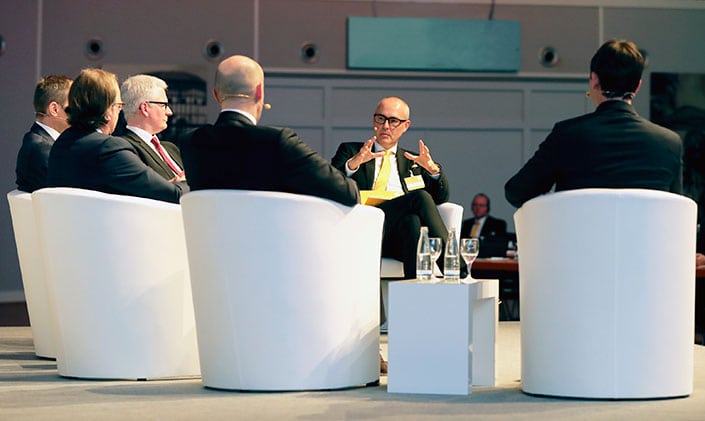New Avenues for the Future of Treasury
Share

The world of business is expanding, corporations of all sizes are becoming more international and treasury is playing an increasing role in corporate finance. Much of this newly-gained clout is owed to the way in which corporate treasurers’ core responsibilities have been at the heart of many global developments in the last few decades, including globalisation and the resulting international trade relationships. Not to forget the financial crises that put the spotlight on things like liquidity and risk – essentially the bread and butter of any treasurer’s daily business.
The treasury function ensures that a business has sufficient liquidity to meet its obligations and manages payments, receipts and financial risks. Treasurers today are strategic business partners across all business areas, adding value to the operating divisions. So while treasurers are more valuable assets to their companies than ever before, it would be a mistake to rest on these laurels and to neglect anticipating what is to come. Corporate treasury is sure to face new challenges in the next few decades, and the way to tackle them is to always remain one step ahead. At BELLIN, we are dedicated and motivated to building revolutionary treasury solutions and we are committed to being leaders, to remaining curious and flexible. Our Avant-garde approach has led us to succeed at being at the forefront of treasury advancement and efficiency. But where are we headed now? Where is treasury headed?
Digitisation and automation In today’s fast-paced, ever changing business environment, manual, paper-based processes are outdated. Treasurers can no longer afford to waste valuable time that would be better put towards more strategic, value-added treasury responsibilities. So how can they ensure that day-to-day administration, processing and transaction execution can be completed using minimal resources? The answer is increased automation and digitisation. The majority of daily financial processing and administration as well as control and monitoring processes can be automated, reducing the amount of time needed to be spent on these tasks. This is impossible without the use of a group-wide treasury management system to maximise integration and straight-through processing. While some areas of treasury have been largely automated, for example payments, others – such as trade finance activities – are lagging behind. There will be no way around digitising these last “paper strongholds” if treasurers want to be fit to meet the challenges of the 21st century.

Efficiency gains and outsourcing
Digitisation and automation go hand in hand with increased efficiency. We believe that while the automation and streamlining of processes as well as the reduction of manual processes is crucial, the potential is ultimately limited. Some daily treasury tasks might still exceed the capacities of a team, or maybe a business would simply like to benefit from the results of a powerful treasury organisation without having to implement any software or set up a corresponding organisational structure. This is why we see outsourcing as an integral part of the future of treasury (at BELLIN’s addressed with the service offering of Treasury as a Service (TaaS)).
The objective of TaaS and outsourcing is the objective of modern treasury management: eliminate inefficient and repetitive tasks that could be performed by someone else. That can be anything from account statement collection and verification, daily financial status reporting, to multilateral reconciliation processes or netting runs. In the past, corporate treasury was to some degree the stronghold of large, multinational corporations. TaaS opens treasury to a whole new target group: to small and medium-sized companies who had previously considered it “beyond their means” to have a dedicated treasury department.
The power of the network
Treasurers are more than data collectors. It goes without saying that a treasury management system can capture data; what really counts is what I do with this information. This is where treasurers’ role as business partners within their own organisation comes in: sharing and being connected are more vital than ever. Group-wide networks ensure visibility and transparency, better and faster data and optimum integration. Connecting to other organisations and third parties boosts industry-wide collaboration and best practices and helps in the search for new solutions and approaches.
Regulations
The last few years have seen a veritable “flood of regulations,” and while no one can predict whether not this is going to continue at a comparable pace, it would be unrealistic to expect a return to a completely non-regulated treasury environment. Operating more globally comes with having to deal with regulations in various different countries and regions. Economic, political and technological developments will continue to pose regulatory challenges, and treasurers will have to remain on their toes to meet them with as much efficiency as possible.
New technologies
Technology continually provides new and enhanced ways for corporates to manage their finances. No one can yet predict if and in what way new technological developments, such as Bitcoin, are going to affect treasury. Coming back to the issue of regulation, we need to understand where technology will require regulating. Building the treasury of tomorrow The more advanced and the more efficient a treasury, the more successful the entire company! Treasury is no guarantee for business success – the world is too complex for that. But treasury is a crucial success factor. BELLIN will continue to play a pioneering role in the industry, so corporates are well prepared for all of these trends.
For more information: www.bellin.com

























